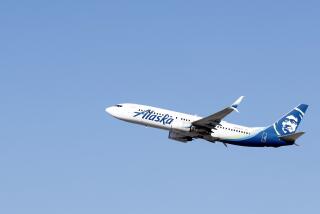A final flight into the history books
FOR WHAT many consider an aviation failure, the DC-10 has had quite a run. But this morning, more than 35 years after the first of the planes was built, Northwest Airlines Flight 98 will pull up to an airport gate in Minneapolis after an eight-hour trip from Hawaii, and the last paying passengers in the U.S. to fly on a DC-10 will disembark.
The DC-10 is indeed a remarkable plane, but not for its innovative wide-body design or even its signature tail-mounted jet engine. Rather, its claim to fame is that no other passenger jetliner has suffered more from the public’s fear of flying.
It’s not necessarily fair. Built at McDonnell Douglas’ Long Beach factory from 1968 to 1989, the DC-10 had its share of high-profile accidents -- but so have the much-less-maligned Boeing 737 and 747, the latter of which has a fatal-accident rate close to the DC-10’s. But popular fears are hard to erase: Just this past June, Wired magazine named the DC-10 the fifth-worst “stupid engineering mistake” in history.
Granted, the DC-10 did have its share of problems after its first flight in 1970. But before 1980, McDonnell Douglas was still selling the planes at a brisk pace. More than 270 DC-10s were in service around the world in 1979; the plane’s chief rival, the Lockheed L-1011, had run into production problems that pushed airlines to buy the DC-10.
But on a May afternoon in 1979, unfairly or not, the public’s perception of the DC-10 would change forever.
American Airlines Flight 191 to Los Angeles ended just seconds after the DC-10 started its takeoff roll in Chicago. As the plane lifted off the runway, the engine mounted on its left wing ripped away and knocked out crucial hydraulic lines that connected the cockpit to the wings, rendering the plane uncontrollable. The left wing lost much of its lift, and the DC-10 came down, rolled over and crashed into a trailer park near O’Hare International Airport, killing all 271 people on board and a few on the ground. An amateur photographer near the airport captured chilling photos of the plane as it turned on its side.
Initially, the Federal Aviation Administration did its due diligence: It worked deliberately and didn’t jump to conclusions. But pressure mounted on then-FAA chief Langhorne Bond to take drastic action; he was called to testify at a House hearing. The public was hungry for a culprit.
In June 1979, Bond dealt the DC-10 what many consider a deathblow: He grounded all 138 DC-10s in service in the U.S.; the order was lifted 37 days later. All but a handful around the world also were grounded.
What was lost in the outcry was the FAA’s final conclusion: American Airlines’ maintenance was mostly to blame for the Flight 191 crash -- not McDonnell Douglas’ design. In fact, of all the fatal DC-10 accidents before 1980, only one crash near Paris was blamed on a design flaw (which McDonnell Douglas and airlines quickly fixed).
Though the DC-10 remained in service, it never truly regained the public’s confidence. American Airlines, which had painted “DC-10 Luxury Liner” on each plane’s fuselage, erased the DC-10 label and went with a less descriptive “American Airlines Luxury Liner.”
In 1989, McDonnell Douglas shut down the DC-10 production line; in all, only 446 (60 of which were sold to the Air Force) were built. By contrast, Boeing has built more than 600 of its similarly sized 777s since 1995.
Ironically, it was partly because of another crash that the DC-10 regained some public trust. In 1989, a crippled United Airlines DC-10 was filmed crash-landing in such a horrific fireball that it looked as if it should have killed all 296 people on board; instead, 185 survived. Experts praised the DC-10’s sturdy design for such a high number of survivors.
So why have U.S. airlines retired their DC-10s? Not because of safety; if that were the case, airlines would have mothballed their fleets immediately after the Chicago crash.
The real reason is that newer planes are far more fuel-efficient -- and therefore less expensive to operate -- than planes from the DC-10 era. In fact, more than 150 DC-10s are still in service, many of them hauling freight for companies such as FedEx (which, for various reasons, are more willing to use secondhand planes even if they’re not as fuel efficient). ATA Airlines recently bought a batch of Northwest’s DC-10s for U.S. military charter flights.
No doubt it’s gratifying for those who built the DC-10 to see their plane go into retirement not as many may have expected -- amid crash investigations or calls to ground the planes.
Instead, by the time you’ve read this, the final DC-10 passenger flight in the U.S. probably has ended exactly as the McDonnell Douglas designers would have wanted -- anticlimactically and without much notice.
More to Read
Inside the business of entertainment
The Wide Shot brings you news, analysis and insights on everything from streaming wars to production — and what it all means for the future.
You may occasionally receive promotional content from the Los Angeles Times.











